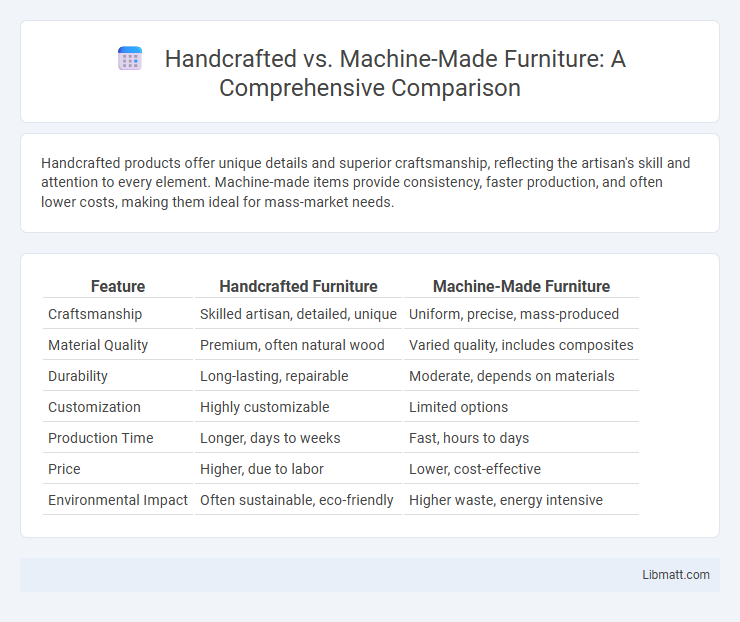Handcrafted products offer unique details and superior craftsmanship, reflecting the artisan's skill and attention to every element. Machine-made items provide consistency, faster production, and often lower costs, making them ideal for mass-market needs.
Table of Comparison
| Feature | Handcrafted Furniture | Machine-Made Furniture |
|---|---|---|
| Craftsmanship | Skilled artisan, detailed, unique | Uniform, precise, mass-produced |
| Material Quality | Premium, often natural wood | Varied quality, includes composites |
| Durability | Long-lasting, repairable | Moderate, depends on materials |
| Customization | Highly customizable | Limited options |
| Production Time | Longer, days to weeks | Fast, hours to days |
| Price | Higher, due to labor | Lower, cost-effective |
| Environmental Impact | Often sustainable, eco-friendly | Higher waste, energy intensive |
Introduction to Handcrafted vs Machine-Made
Handcrafted products showcase meticulous artistry and unique imperfections that reflect skilled human craftsmanship, while machine-made items emphasize precision, consistency, and mass production efficiency. Your choice between these depends on valuing personalized detail over uniformity and speed. Understanding the distinct qualities of handcrafted versus machine-made goods helps in selecting items that best suit your preferences for authenticity or practicality.
Defining Handcrafted Products
Handcrafted products are created by skilled artisans using traditional techniques and manual tools, emphasizing unique craftsmanship and attention to detail. Each item often exhibits subtle variations, reflecting the artisan's expertise and creativity. These products typically prioritize quality and individuality over mass production efficiency found in machine-made goods.
Understanding Machine-Made Goods
Machine-made goods are produced using automated processes and precision machinery, enabling high-volume manufacturing with consistent quality. These products often feature uniformity and lower production costs due to reduced labor input and faster production times. The use of advanced technology in machine-made goods also allows for intricate designs and standardized specifications that might be difficult to achieve by hand.
The Craftsmanship Factor
Handcrafted items showcase the unique skills and meticulous attention to detail of artisans, resulting in higher quality and distinctive character compared to machine-made products. The craftsmanship factor ensures each piece carries individual imperfections and artistic value that machines cannot replicate. This contributes to the exclusivity and often higher durability of handcrafted goods in contrast to mass-produced alternatives.
Production Speed and Efficiency
Handcrafted products typically require significantly more time and skilled labor, resulting in lower production speed and reduced efficiency compared to machine-made goods. Machine-made production leverages automation and standardized processes to achieve high-speed output and consistent quality, optimizing efficiency across large manufacturing volumes. This stark contrast in production speed and efficiency often influences cost, scalability, and market availability between handcrafted and machine-made items.
Cost Comparison: Handcrafted vs Machine-Made
Handcrafted products typically incur higher costs due to labor-intensive processes and skilled artisan expertise, leading to limited production volumes and increased material expenses. Machine-made items benefit from economies of scale, automated production lines, and faster manufacturing times, resulting in significantly lower unit costs. Price differences reflect not only production methods but also factors such as customization levels, quality consistency, and material sourcing.
Quality and Durability Differences
Handcrafted products often exhibit superior quality due to meticulous attention to detail and skilled artisanship, resulting in unique and durable items. Machine-made goods typically offer consistency and faster production but may lack the refined craftsmanship that enhances longevity. Durable materials combined with expert hand-finishing generally ensure handcrafted items outperform mass-produced counterparts in wear resistance and aesthetic longevity.
Environmental and Ethical Impacts
Handcrafted products typically have a lower environmental footprint due to the use of sustainable materials and minimal energy consumption compared to machine-made items, which often rely on mass production processes that generate significant waste and carbon emissions. Ethical considerations favor handcrafted goods as they support fair wages and safe working conditions for artisans, while machine-made production can involve exploitative labor practices and poor workplace standards. Choosing handcrafted products aligns with your values by promoting environmental sustainability and ethical responsibility in the supply chain.
Consumer Preferences and Trends
Consumer preferences increasingly favor handcrafted products for their uniqueness, artisanal quality, and sustainable production methods. Machine-made items attract buyers with their affordability, consistency, and mass availability, catering to convenience-driven markets. Trends indicate a growing niche market for handcrafted goods, driven by a desire for personalized and ethically produced products.
Making the Right Choice for You
Evaluating handcrafted versus machine-made products involves considering factors like customization, quality, and production speed. Handcrafted items offer unique, personalized touches with superior craftsmanship, while machine-made goods provide consistency and affordability in mass production. Selecting the right choice depends on your priorities, such as valuing exclusive design or efficient cost-effectiveness.
Handcrafted vs machine-made Infographic

 libmatt.com
libmatt.com